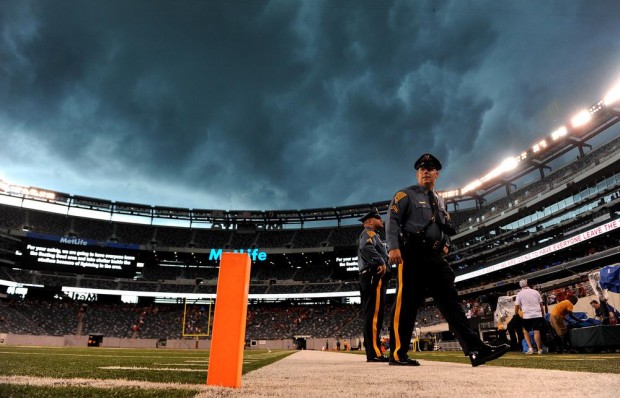Football
New Jersey’s weather could prove problematic in Super Bowl
Ominous storm clouds move over MetLife Stadium in East Rutherford, N.J., as a 2012 college game between USC and Syracuse University is delayed at halftime because of lightning.
During this Sunday’s New York/New Jersey Super Bowl between the Denver Broncos and the Seattle Seahawks, we may well see a scene like this.
Now contrast this image with one that is much more likely, given the typical February conditions of northern New Jersey and my hometown New York City. Cold, miserable fans drive or march through at least one unappealing winter substance—snow, slush or ice. Next, these fans must stand for hours in long, outdoor security lines (it is the Super Bowl, after all) just to get the chance to sit outside for another three-and-a-half-hours to watch the game, whose participating players are probably even more miserable, given their relative lack of layers.
There are, however, obvious flaws with even the slightest chill or light precipitation of the more Rockwellian picture outlined earlier. Should watching a football game be experiential, with fans in attendance firmly believing that they affect the outcome of the game, thus feeling that there should be a form of sacrificial suffering involved in rooting a team to victory? Many Seahawks fans would attest to this theory, given their pride in the “The 12th Man” collection of raucous Seattle fans. Or should it be purely observational as fans watch from the warmth and comfort of their own homes?
Here in St. Louis, with temperatures in the teens as they’ve been this week, most can barely summon the will for a 10-minute walk to class in the cold, let alone the effort it must take to stomach five hours in the tundra. As of writing this piece, the current weather forecast for East Rutherford, N.J., according to weather.com, is a high of 44 degrees. The low in Miami, Fla., one of the more popular sites for the Super Bowl, is 70 degrees. Where would you rather watch the big game?
One last question remains: to what extent should the Super Bowl, American football’s highest point of competition and the gold standard for all other televised sporting events, be decided in conditions that could certainly affect the athletic performance of its players? How much of Peyton Manning’s football legacy should be wrapped up in his ability to throw a tight spiral through biting winds with a hand numb from the cold? If Seattle wins based on the might of its stout defense and grinding running attack, can we justify giving the team football’s highest accolades if they came under circumstances of low temperature, high wind and precipitation that all could benefit the Seahawks’ greatest strengths and possibly sap the Broncos of the efficiency of their historically great offense?
According to a FiveThirtyEight article by Harry Enten, who analyzed early February weather reports in northern New Jersey over the past 30 years, there is a 50 percent chance that one weather condition—temperature below 25 degrees, wind above 15 miles per hour, or any precipitation—will occur and affect the game. The intersection of two of these categories is smaller, at just 20 percent. And freezing, snowy and extremely windy conditions have occurred only 3 percent of the time.
Even though it is unlikely that the weather will absolutely affect the play on the field, there is still an undeniable possibility of poor conditions, and even if the temperature is a cold 35 degrees and not a frigid 25, most fans will be still be unhappy.
It might be even worse for the Super Bowl’s future if the weather is not a factor and things go smoothly on game day as this will probably prompt the NFL to consider such ice-cold outdoor locations as Philadelphia, Chicago and New England for future Super Bowls. Maybe Super Bowl LIII in 2019 will be played in a foot of snow, 35 mile-per-hour winds or subzero temperatures. I, for one, will be happy to watch from the couch, wrapped in the warmest blanket I can find.

